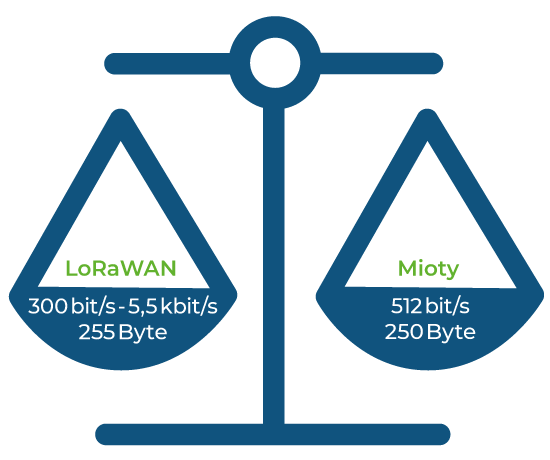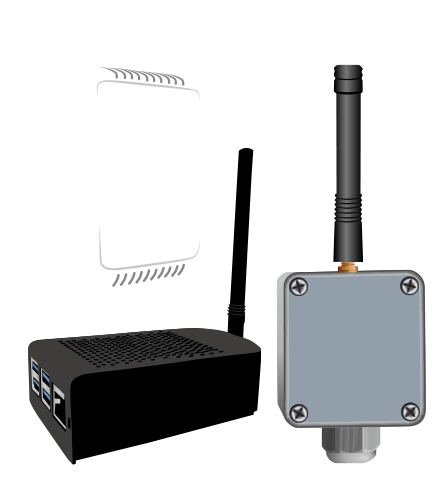Mioty – The new star in the LPWAN sky?
What is Mioty?
Mioty radio technology from the Fraunhofer Integrated Circuits Institute promises to improve the Internet of Things. We take a look at the still young technology and provide an overview of the differences to the already successful LoRaWAN technology.
The European Telecommunications Standards Institute (ETSI) has published a standard (TS 103 357) to promote the development of massive, industrial IoT solutions, as well as to replace the Wireless Meter Bus (M-Bus) standard, which represents the current status quo in smart metering in Europe. Mioty was the first and currently the only company to meet this still young requirement.
Like Semtech's LoRa technology, Mioty uses the license-free spectrum, which is 868 MHz in Europe and 915 MHz in the USA. For this reason, there are no transmission fees for the use of this IoT technology and the user retains control of his transmitted data vis-à-vis third parties.
However, radio transmission on these, license-free wavelengths is more susceptible to interference. Transmission losses occur and messages can be lost. This is where Mioty plays to its strength of "Telegram Splitting".
While a packet loss of 10% is to be expected when using LoRa and in this case a transmission fails, the technology developed by the institute from Erlangen promises a successful data transmission with even up to 50% packet loss. Like LoRa, Mioty works on the basis of a spreading method, but instead of one packet, the message is split into several "sub-packets". These "sub-packets" are sent on different frequencies and with a high redundancy of information.
The resulting increased reliability in transmitting data makes higher penetration in unfavorable terrain possible, making Mioty ideal for large-scale deployment of sensors even in difficult circumstances (such as underground mining). It is when consistently successful transmission is essential that this technology can shine. The lower interference problems despite a strong radio traffic allow a higher number of transmitters in the system to communicate.
LoRaWAN and Mioty - A direct comparison
End devices are connected via the Mioty software and similar to LoRaWAN by means of an EUI (Extended-Unique-Identifier) and a network key. The battery life of both technologies are also close. Usually, a runtime of up to 15 years is specified for LoRaWAN, which is supposed to be even longer for Mioty. A consumption of 17.8 μWh per endpoint is given by the Fraunhofer Institute. Telegram splitting enables a particularly short transmission time and requires less than 400ms for a transmission of an exemplary sensor. As a result of the shorter operating time of the transmit amplifier, less energy is required, resulting in minimal network maintenance and, in theory, eliminating the need for battery replacement for up to 20 years. In addition, the endpoints could be combined with Fraunhofer IIS energy harvesting technology, which uses minimal vibration or temperature differences to generate energy.


There are still minor differences in the payload size of both transmission protocols. The maximum size of a Mioty message is 250 bytes compared to the 255 bytes of a LoRa message. The transmission rate of the Fraunhofer technology is 512 bit/s, for LoRaWAN the range is between 300 bit/s and 5.5 kbit/s.
For LoRaWAN, there is virtually no speed limit for transmitting data from transmitters or receivers that are in motion. For Mioty, successful transmission of data at up to 120km/h with some resistance to the Doppler effect is specified, but this should be sufficient for a large majority of use cases.
Mioty Hardware
Even if the supply of Mioty hardware is currently scarce: By using MSK modulation for Mioty, most of the radio ICs already available on the market can be used, which should make it easier for hardware manufacturers to expand their portfolio to Mioty devices in the future. Due to the specification as Software Defined Radio, integration into existing radio sensors is often possible without much development effort.
While users will not be charged radio fees, Mioty is not an open-source platform and must first be licensed by interested parties who wish to offer custom IoT solutions. To that end, Sisvel International S.A. is pursuing new joint patent licensing for the Mioty technology. The platform started with patents owned or controlled by the Fraunhofer Institute for Integrated Circuits IIS and Diehl Metering GmbH.

 Conclusion
Conclusion
Mioty is not expected to displace already established LPWAN technologies. Rather, it is expected that this radio technology will become interesting for industrial or urban IoT applications on a large scale, especially due to its reliability and robustness, as an addition to the LPWAN landscape.
Currently, however, the technology is still in its infancy and has yet to prove itself in the market. There is very little available hardware and there is no extensive ecosystem as with the other LPWAN technologies that have already proven themselves in reality. Only time will tell if this will work with this licensable technology. However, the Mioty Alliance, which aims to make the technology the standard for large-scale or industrial IoT projects and whose founding members include Texas Instruments, Fraunhofer Institute for Integrated Circuits IIS, Diehl Metering, Diehl Connectivity Solutions, ifm, Ragsol, STACKFORCE, and WIKA, certainly give cause for optimism in this regard.
Would you like advice on the available IoT technologies?
You want an IoT network but don't know which one is right for your application? We are happy to advise you! We also support you in the question if and how several IoT technologies can be used.

